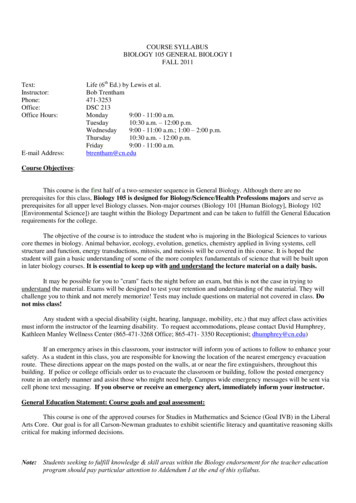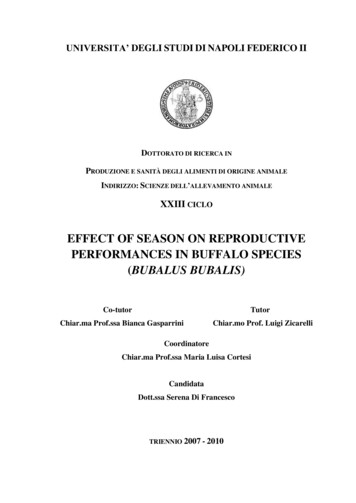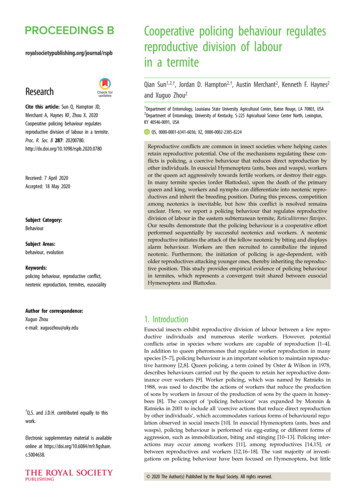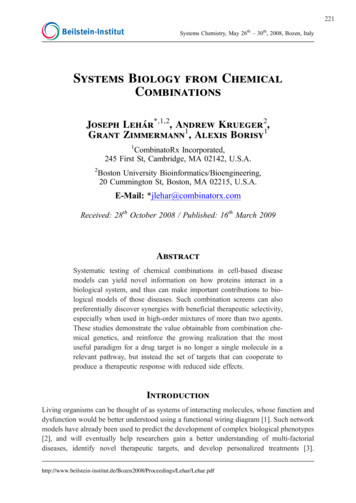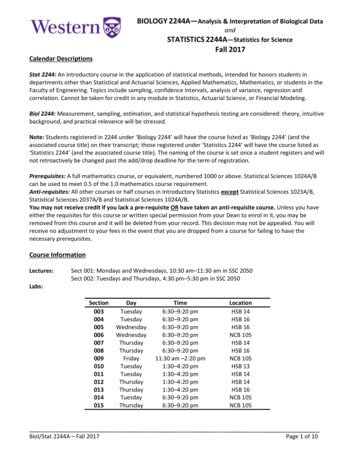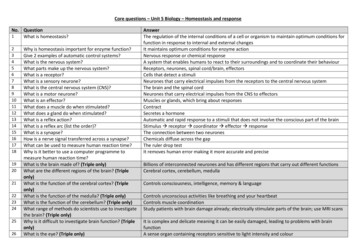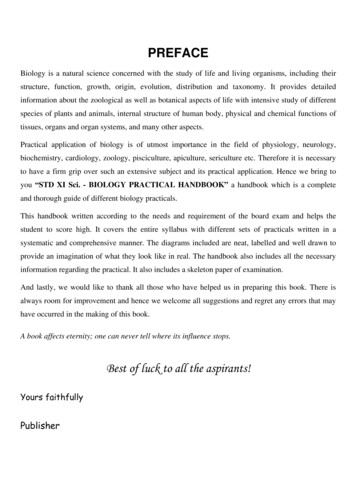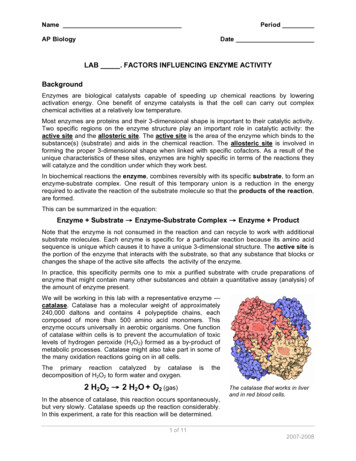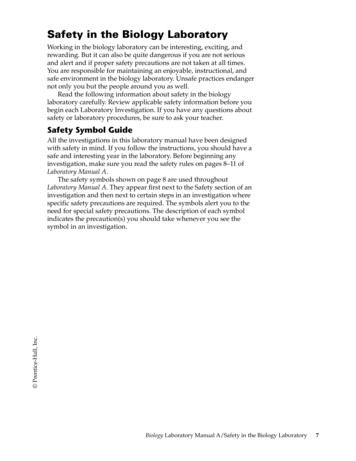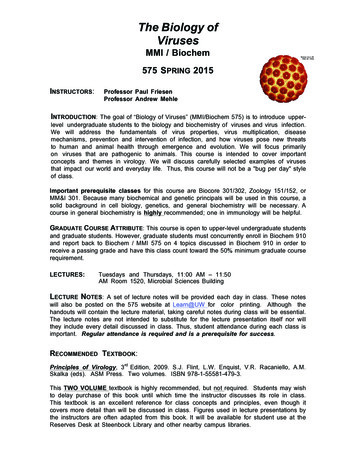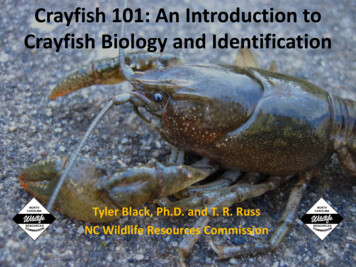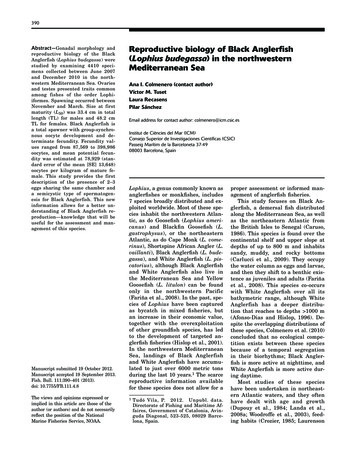
Transcription
390Abstract— Gonadal morphology andreproductive biology of the BlackAnglerfish (Lophius budegassa) werestudied by examining 4410 specimens collected between June 2007and December 2010 in the northwestern Mediterranean Sea. Ovariesand testes presented traits commonamong fishes of the order Lophiiformes. Spawning occurred betweenNovember and March. Size at firstmaturity (L50) was 33.4 cm in totallength (TL) for males and 48.2 cmTL for females. Black Anglerfish isa total spawner with group-synchronous oocyte development and determinate fecundity. Fecundity values ranged from 87,569 to 398,986oocytes, and mean potential fecundity was estimated at 78,929 (standard error of the mean [SE] 13,648)oocytes per kilogram of mature female. This study provides the firstdescription of the presence of 2–3eggs sharing the same chamber anda semicystic type of spermatogenesis for Black Anglerfish. This newinformation allows for a better understanding of Black Anglerfish reproduction—knowledge that will beuseful for the assessment and management of this species.Manuscript submitted 19 October 2012.Manuscript accepted 19 September 2013.Fish. Bull. 111:390–401 (2013).doi: 10.7755/FB.111.4.8The views and opinions expressed orimplied in this article are those of theauthor (or authors) and do not necesarilyreflect the position of the NationalMarine Fisheries Service, NOAA.Reproductive biology of Black Anglerfish(Lophius budegassa) in the northwesternMediterranean SeaAna I. Colmenero (contact author)Víctor M. TusetLaura RecasensPilar SánchezEmail address for contact author: colmenero@icm.csic.esInstitut de Ciències del Mar (ICM)Consejo Superior de Investigaciones Científicas (CSIC)Passeig Marítim de la Barceloneta 37-4908003 Barcelona, SpainLophius, a genus commonly known asanglerfishes or monkfishes, includes7 species broadly distributed and exploited worldwide. Most of these species inhabit the northwestern Atlantic, as do Goosefish (Lophius americanus) and Blackfi n Goosefi sh (L.gastrophysus), or the northeasternAtlantic, as do Cape Monk (L. vomerinus), Shortspine African Angler (L.vaillanti), Black Anglerfish (L. budegassa), and White Anglerfish (L. piscatorius), although Black Anglerfishand White Anglerfi sh also live inthe Mediterranean Sea and YellowGoosefi sh (L. litulon) can be foundonly in the northwestern Pacific(Fariña et al., 2008). In the past, species of Lophius have been capturedas bycatch in mixed fi sheries, butan increase in their economic value,together with the overexploitationof other groundfish species, has ledto the development of targeted anglerfish fisheries (Hislop et al., 2001).In the northwestern MediterraneanSea, landings of Black Anglerfishand White Anglerfish have accumulated to just over 6000 metric tonsduring the last 10 years.1 The scarcereproductive information availablefor these species does not allow for a1Tudó Vila, P. 2012. Unpubl. data.Directorate of Fishing and Maritime Affaires, Government of Catalonia, Avinguda Diagonal, 523-525, 08029 Barcelona, Spain.proper assessment or informed management of anglerfish fisheries.This study focuses on Black Anglerfish, a demersal fish distributedalong the Mediterranean Sea, as wellas the northeastern Atlantic fromthe British Isles to Senegal (Caruso,1986). This species is found over thecontinental shelf and upper slope atdepths of up to 800 m and inhabitssandy, muddy, and rocky bottoms(Carlucci et al., 2009). They occupythe water column as eggs and larvae,and then they shift to a benthic existence as juveniles and adults (Fariñaet al., 2008). This species co-occurswith White Anglerfi sh over all itsbathymetric range, although WhiteAnglerfish has a deeper distribution that reaches to depths 1000 m(Afonso-Dias and Hislop, 1996). Despite the overlapping distributions ofthese species, Colmenero et al. (2010)concluded that no ecological competition exists between these speciesbecause of a temporal segregationin their biorhythms; Black Anglerfish is more active at nighttime, andWhite Anglerfish is more active during daytime.Most studies of these specieshave been undertaken in northeastern Atlantic waters, and they oftenhave dealt with age and growth(Dupouy et al., 1984; Landa et al.,2008a; Woodroffe et al., 2003), feeding habits (Crozier, 1985; Laurenson
Colmenero et al.: Reproductive biology of Lophius budegassa in the northwestern Mediterranean Sea391Figure 1Map of study area where specimens of Black Anglerfish (Lophius budegassa) were collected inthe northwestern Mediterranean Sea between June 2007 and December 2010 to examine thereproductive biology of this species. The zone shaded in light gray closest to the Catalan coastindicates the sampling area. The cities shown on the coast were the ports of commercial trawlfishery vessels from which specimens were collected.and Priede, 2005; Preciado et al., 2006), geographicaland depth distribution (Caruso, 1985; Landa et al.,2008b; Velasco et al., 2008), and reproduction (AfonsoDias and Hislop, 1996; Duarte et al., 2001; Laurenson,2006). In the Mediterranean Sea, studies have beenless numerous and for the most part have focused onbiological aspects similar to the ones examined in thestudies just described (Carlucci et al., 2009; Colmenero et al., 2010; García-Rodríguez et al., 2005; La Mesaand De Rossi, 2008; Maravelias and Papaconstantinou,2003; Negzaoui-Garali and Ben Salem, 2008; NegzaouiGarali et al., 2008; Tsimenidis, 1984; Tsimenidis andOndrias, 1980; Ungaro et al., 2002). However, only Tsimenidis (1980) and Carbonara et al. (2005) focused onreproductive traits of Black Anglerfish.Information about the duration of the spawning season, fish size at first maturity, reproductive strategy,maturation of oocytes, and fecundity are very relevantfor studies of the biology and population dynamicsused in stock assessments for management of fisheryresources. Of all these reproductive features, fecundity is the most difficult biological parameter to obtain,although it is critical for accurate stock assessments(Trippel et al., 1997). In the peculiar case of species ofLophius, studies on fecundity are scarce because of thedifficulty of 1) acquisition of suitably mature individuals in the maturity phases of spawning capable or actively spawning and 2) the use of a proper method forfecundity estimation, which is especially complicatedbecause of the morphological features of the gonads ofthese species. During reproduction, a gelatinous material is secreted into the lumen, and enumeration andmeasurement of eggs embedded in this mucus matrixis extremely difficult.Although species of Lophius have similar traitsthroughout the world, some biological aspects andcatch trends of fisheries present interspecific and spatial variations (Fariña et al., 2008). For that reason,reproductive parameters of the Atlantic stock of BlackAnglerfish cannot be applied to the stock in the Mediterranean. In addition, knowledge of the reproductivebiology of this species in the northwestern Mediterranean Sea is very limited. Therefore, our study is thefirst one to take a detailed approach to the examination of reproductive traits of Black Anglerfish in theMediterranean Sea, and the results of this study cancontribute to improvement of stock assessment and effective management of this species in this region.Materials and methodsSample collectionMonthly samples of Black Anglerfi sh were obtainedfrom 467 sampling stations situated in the fi shinggrounds off the Catalan coast in the northwesternMediterranean Sea from 40 5.980′N to 43 39.310′N
392Fishery Bulletin 111(4)Table 1Macroscopic and microscopic description of the 5 maturity phases in the reproductive cycle of male and female Black Anglerfish (Lophius budegassa) collected from the northwestern Mediterranean Sea between June 2007 and December 2010;adapted from Afonso-Dias and Hislop (1996) and Brown-Peterson et al. (2011).PhaseMalesFemalesImmature (I)Testes are long, narrow, and tubularshaped. They are translucent with novisible vascularization. The medial seminiferous duct is distinct. Only spermatogonia and primary spermatocytes arepresent.Ovaries are very narrow, thin, and flattened-tubeshaped. They are translucent; no oocyte clustersvisible and minimal vascularization. Only oogoniaand primary growth oocytes are present.Developing/Regenerating (II)Testes are small with visible blood vessels around the seminal duct. Spermatogonias, primary and secondary spermatocytes are predominant. Spermatids arescarce.Ovaries are small. Still no noticeable individual oocyte clusters. They acquire a cream color and vascularization is visible. Only oogonia and primarygrowth oocytes are present.Spawning capable (III)Testes increase in length and width. Theyhave a firm texture and cream color. Seminal duct is highly vascularized. Germcells at all stages of spermatogenesis arepresent. Spermatids are predominantwith a lot of spermatozoa in the lumen ofthe sperm duct.Ovaries increase in width and length. They have alight orange color, and blood vessels are prominent.The edges of the ovaries start to curl and they occupy a larger proportion of the body cavity. A mucusmatrix starts to develop. Primary growth, corticalalveolar, and primary and secondary vitellogenic oocytes are present.Actively spawning (IV)Testes are large and firm and have acreamy coloration. Large amounts ofsperm produced when testes are dissected. Abundant quantities of spermatozoaare present in the seminiferous tubules.Ovaries are extremely long and wide and occupymost of the body cavity. The color of the oocytes is orange, and they are visible macroscopically. Ovariesare characterized by the presence of large hyalineoocyte clusters enclosed in a transparent gelatinousmatrix that is completely developed. High vascularization is present. Oocytes are in tertiary vitellogenesis, migratory nucleus and hydration.Regressing (V)Testes are small, flaccid, and have brownor red areas in their beige surface. Theyare still highly vascularized. Sperm andresidual spermatozoa can be found in thelumina of the sperm duct. Spermatogoniaare present in the testes cortex.Ovaries are flaccid and highly vascularized and often have longitudinal striations. Their color is darkpink or red. Atresia and postovulatory follicles,together with primary growth stages, are present.Cortical alveolar, primary and secondary vitellogenesis can be found.and from 0 32.922′E to 3 35.718′E between June 2007and December 2010. Specimens were collected onboardcommercial trawl fishery vessels at depths of 20–600m and identified according to Caruso (1986). The trawlfleet belonged to the ports of Roses, Blanes, Arenys deMar, Vilanova i la Geltrú, and Sant Carles de la Ràpita(Fig. 1). For this study, 4410 specimens were measuredto the nearest centimeter in total length (TL), weighedto the nearest gram in total weight (TW) and guttedweight (GW), and measured with an accuracy of 0.01 gin gonad weight (GNW) and liver weight (LW).Macroscopic and histological description of gonadsOf the total number of specimens, 3562 fish had gonadsremoved and their sex was determined, and they wereassigned macroscopically to a gonadal stage on the basisof a scale with 5 maturity phases that were describedin previous studies: immature (phase I), developing orregenerating (phase II), spawning capable (phase III),actively spawning (phase IV), and regressing (phase V)(Afonso-Dias and Hislop, 1996; Brown-Peterson et al.,2011) (Table 1). Sex was easily assessed macroscopically in mature individuals. However, gonads from smallindividuals (approximately 20 cm TL) were indistinguishable macroscopically because ovaries and testeswere small, translucent, and string-like. Fish that weretoo small to determine their sex or assign to a gonadalphase were classified as indeterminate.To corroborate the macroscopic classification ofsome unclear and undetermined gonads, 372 specimens were histologically examined. They were fixed in10% buffered formalin solution before they were dehydrated and embedded in a methacrylate polymer resin.
Colmenero et al.: Reproductive biology of Lophius budegassa in the northwestern Mediterranean SeaCross sections, each 3–4 µm thick, were made with amanual microtome Leica Reichert-Jung 2040 (LeicaMicrosystems,2 Wetzlar, Germany), stained with Lee’sstain (methylene blue and basic fuchsin), and mountedin a synthetic resin of dibutyl phthalate xylene (DPX)on microscope slides. Gonads were classified accordingto the morphological features and the presence of specific inclusions (oil droplets, yolk granules, yolk vesicles, or postovulatory follicles) (Wallace and Selman,1981). The ovarian and testicular phases were definedby the developmental stage of the most advanced cellwithin the gonad (Yoneda et al., 1998b).Spawning season and size at first maturityThe spawning season was established from the analysis of the monthly variation of the maturity phases andthe changes in gonadosomatic (GSI) and hepatosomatic (HSI) indices for each sex (Afonso-Dias and Hislop,1996). Because immature specimens were not considered, 1437 males and 1167 females were used to determine both indices, which were calculated according toYoneda et al. (2001) with the following equations:GSI (GNW / GW) 100.(1)HSI (LW / GW) 100.(2)Size at first maturity (L50) was determined through theexamination of males and females in mature phases(phase III, phase IV, or phase V) and immature individuals collected during the spawning period (Duarteet al., 2001). Total length of all individuals was usedto estimate L50, defined as the size at which 50% of allfish sampled were at sexually mature phases. Maturitycurves were determined with a logistic curve (Pope etal., 1975):P 100 / (1 exp [a bTL]),(3)where P the percentage of mature individuals as afunction of size class (TL); anda and b specific parameters that can change duringthe life cycle.A logarithmic transformation was applied to this equation to calculate the parameters a and b by means ofli
catch trends of fi sheries present interspecifi c and spa-tial variations (Fariña et al., 2008). For that reason, reproductive parameters of the Atlantic stock of Black Anglerfi sh cannot be applied to the stock in the Medi-terranean. In addition, knowledge of the reproductive biology of this species in the northwestern Mediterra-
